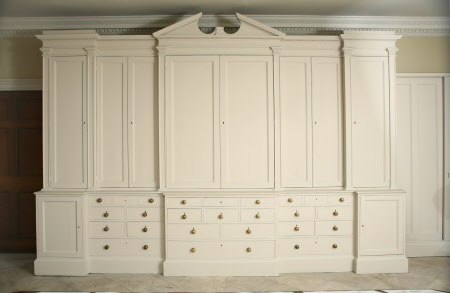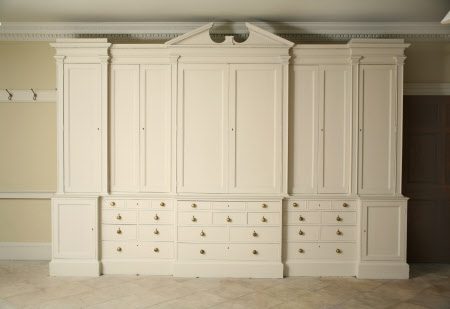The Nostell Priory Muniment Bookcases - circa 1776
probably Robert Adam (Kirkcaldy 1728 - London 1792)
Category
Furniture
Date
circa 1776
Materials
Painted pine, oak cockbeads, brass, painted titles
Place of origin
London
Order this imageCollection
Nostell Priory, West Yorkshire
NT 959803.2
Summary
A white-painted pine breakfront muniment bookcase, English, circa 1776, one of a pair, and part of a set with a smaller pair NT 959804.1 & .2. Probably designed by Robert Adam (1728 - 1792) for Sir Rowland Winn (1739 - 1785). NT 959804.2 with pigeonholes titled 'Lettres et Papiers d'Affairs dans la Suisse...', almost certainly a reference to papers relating to the property and business of Sabine Winn, Sir Rowland Winn's Swiss wife. This example with a broken pediment above the central bay and a moulded cornice along the bookcase’s length. With panelled doors spaced by fluted pilasters topped by Corinthian capitals. Fitted with later brass knob handles of the 1820s/1830s and some 21st century replacement copies. Originally fitted with oval backplates and bail handles. Raised on a plinth base. The drawers of pine, the cockbeading of oak.
Full description
The bays to this bookcase arranged as follows: Far-proper right bay upper cupboard – pigeonholes. Titled ‘Annual Letters Received’, lettered pigeonholes. Far-proper right lower cupboard – divisions creating two rows of two compartments. Inner proper right bay upper cupboard – divisions creating numerous pigeonholes. Inner proper right bay lower drawer arrangement – long drawer faced with cockbeading as three short, two short, two short, one long Central two-door bay upper cupboard – divisions creating numerous pigeonholes titled 'Private Letters & Accounts', lettered pigeonholes, shelves and a small drawer. Central two-door bay lower drawer arrangement – long drawer faced with cockbeading as three short, three short, two short, one long. Inner proper left bay upper cupboard – divisions creating numerous pigeonholes. Inner proper left bay lower drawer arrangement - long drawer faced with cockbeading as three short, two short, two short, one long Far-proper left bay upper cupboard – pigeonholes. Titled ‘Annual Bills Answered’, lettered pigeonholes. Far-proper left lower cupboard – divisions creating two rows of two compartments. -- The Muniment Room was originally established for Sir Rowland Winn, 4th Baronet by James Paine circa 1750, as 'The Common Eating Room', or 'Stone Parlour', presumably for everyday family meals [James Paine's plan of ground floor published in Vitruvius Britannicus in 1760s]. Joseph Rose accounts for 1767 refer to 'repairing cornice & ornamental frames & the stucco on the walls of the Dining Room Basement story'. It was probably refurbished as a Muniment Room soon after 1776, when the 5th Baronet wrote a memorandum to Robert Adam concerning 'A room for keeping the family writings' [see Robert Adam's plan of ground floor of 1776 in archives]. The muniment bookcases on the north and south walls, in the piers of the windows and in the door alcove were probably installed at this time. The archives contain 18th century designs for very similar bookcases by an unidentified draughtsman including a design for an eight-door breakfront press, a four-door breakfront press, and a design for a press for papers with shelves in its central section and cupboards on either side - possibly drawn by Rowland Winn. The design is very similar to the bookcases in the piers, and a detail plan of pigeonholes with compartments shows labels for 'Steward/Annual.../...Accounts/and/Papers Relative/to the same, Lettres/et/Papiers d'Affaires...' etc, which correspond to labels to NT 959804.1 & 2. In the 1806 and 1818 inventories, the Muniment Room retains the name 'Stone Parlour' from its first incarnation. In 1806, the contents are listed as a 'Library table', 'Writing desk on a frame', 'Mahogany card table', 'Library steps and stool', 'Press with brass mouldings', '4 chairs', '2 lamps and shades'. The bookcases appear to have been treated as fittings and are not listed. In the 1818 inventory, which is more comprehensive than the first, the contents are as follows: 'Mahogany library table covered with leather', 'Mahogany writing desk', 'Mahogany card table', 'Library steps and stool', '3 mahogany writing tables', 'Mahogany table with cupboard', 'Mahogany reading table to rise', 'Two large deal bookcases' [muniment bookcases], '2 less ditto - in piers' [muniment bookcases], '1 large settee', '1 large & 1 less elbow chair', 'Small mahogany table', 'Stool', 'Small trunk', 'Deal box', 'Bow range, fender, tongs & shovel'. The cupboards and drawers to these bookcases are fitted with extremely fine and elaborate locks and escutcheons formed from three circles. Two surviving keys, with engraved decoration to their shafts and bows, fit these locks. The fine quality of the metal furniture is a testament to the importance of these bookcases as the repositories for the most important family papers. The keys are a very close match for the keys to the bookcases - designed by Robert Adam - which line the Library. Another measure of their quality is the graded distance between the handle backplates to the drawers which increase in size down the height of the cabinet. They are a rare survival of 18th century domestic furniture. (Megan Wheeler, 2017)
Provenance
Probably acquired by Sir Rowland Winn in 1776 and thence by descent. Purchased by the National Trust in 2002 with the assistance of the National Heritage Memoria] Fund (NHMF), the Heritage Lottery Fund (HLF), and the National Art Collections Fund (NACF).
Makers and roles
probably Robert Adam (Kirkcaldy 1728 - London 1792), designer

